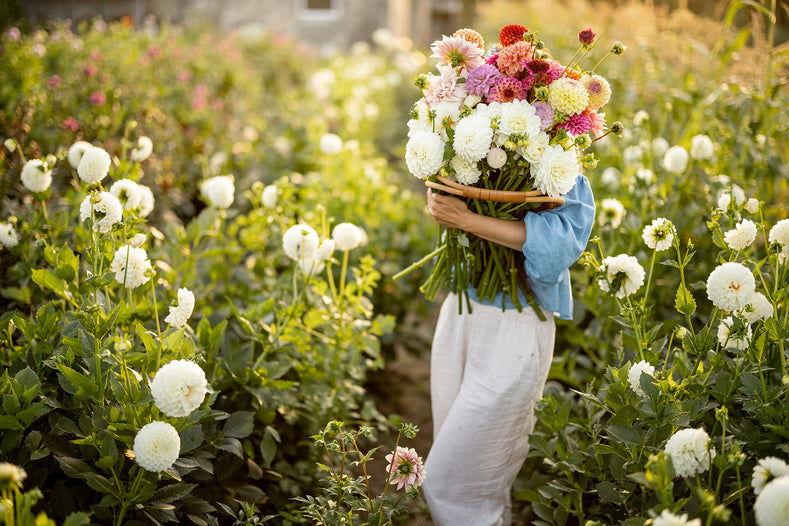Planting bulbs and perennials in the spring is like setting the stage for a summer-long garden party. It's not just about the flowers; it's about bringing a burst of life and color that keeps the show going right until the curtains of fall draw close. Here's why I find it so rewarding:
Imagine your garden as a stage, and each plant is a performer. Spring-planted friends ensure there's never a dull moment, filling in the gaps when the early spring bloomers take their final bow, keeping the garden lively with their continuous performances. Mixing in bulbs and perennials is like painting with a rich palette of colors, shapes, and textures. It's this variety that makes your garden a feast for the eyes and a haven for our little pollinator buddies. Many bulbs come out swinging in their first season, giving you that instant gratification we all love. Perennials, on the other hand, are the gift that keeps on giving, getting fuller and more fabulous with each passing year. These plants are the unsung heroes that bridge the gap between spring's last hurrah and autumn's crisp beginnings, ensuring your garden transitions smoothly through the seasons. Once they've settled in, many of these plants are the epitome of low-maintenance love. They're the hardy souls that keep on thriving, even when the going gets tough, making your garden a resilient oasis. There's nothing quite like seeing your garden abuzz with life, from butterflies flitting about to bees doing their vital work. It's a bustling ecosystem right on your doorstep, thanks to the variety these plants bring. These plants do more than just look pretty; their roots dig deep, helping to break up the soil, keep it from washing away, and locking in that precious moisture. For me, there's a deep joy in watching the garden evolve through the seasons, a reminder of the cycles of life and growth. It's a hands-on way to connect with nature and find a moment of peace in the hustle and bustle of life. Perennials and bulbs are the gifts that keep on giving, not just to us but to future generations of gardeners. They multiply, allowing us to share the bounty with friends, family, and neighbors, spreading the love one plant at a time.
So, why plant in spring? It's about setting the scene for a summer filled with growth, color, and life, a personal retreat that evolves and thrives year after year. It's one of the most rewarding experiences for any gardener, seasoned or just starting out.
Here's a list of bulbs suitable for spring planting, along with planting tips and regional adaptability:
Dahlias
Planting Tips: Plant dahlias in a location with full sun and well-drained soil after the danger of frost has passed. Dahlias need deep planting, about 4-6 inches deep, with spacing of about 18-24 inches apart.
Regions: Best in USDA zones 8-11 as perennials, but can be grown in cooler zones if the tubers are lifted and stored over winter.
Gladiolus
Planting Tips: For continuous blooms, plant gladiolus corms every 10-14 days from spring until early summer. Plant them in full sun, 4 inches deep, and about 6 inches apart.
Regions: Suitable for USDA zones 7-10; in cooler regions, they can be lifted in fall and stored over winter.
Lilies (Asiatic, Oriental, and others)
Planting Tips: Plant lily bulbs in a location with full sun to partial shade and well-drained soil. Plant them about 4-6 inches deep, with spacing according to the variety's size at maturity.
Regions: Hardy in USDA zones 4-9, depending on the variety.
Calla Lilies
Planting Tips: Plant calla lilies in spring in a sunny or semi-shaded area with well-drained soil, about 3 inches deep and 12-18 inches apart.
Regions: Thrive in USDA zones 8-10 as perennials but can be grown in cooler zones with winter protection or by lifting and storing indoors.
Begonias
Planting Tips: Ideal for shaded garden areas or pots. Plant begonia tubers hollow side up, about 1 inch deep. Keep the soil moist but not waterlogged.
Regions: Best in USDA zones 9-11; in cooler climates, they can be grown as annuals or moved indoors for winter.
Calla Lilies (Zantedeschia)
Planting Tips: For Calla Lilies, you'll want to plant them in a spot that gets plenty of sunlight but is cool enough to protect their blooms. Choose a site with rich, well-drained soil. Bury the bulbs about 3 inches deep and space them roughly 12 inches apart. They enjoy a bit of moisture, so don't let them dry out too much, especially during their growing and blooming phases.
Regions: Calla Lilies are perfect for gardeners in USDA zones 8-10. If you're gardening in cooler zones, no worries! You can lift the bulbs in the fall and tuck them away indoors to overwinter. Come spring, they're ready to dazzle again.
Anemones
Planting Tips: Soak anemone bulbs for a few hours before planting to encourage germination. Plant in well-drained soil, 1-2 inches deep, in full sun to partial shade.
Regions: Best in USDA zones 7-10; in cooler zones, provide a protective mulch layer in winter.
Freesias
Planting Tips: Plant freesia bulbs (corms) about 2 inches deep and 2-3 inches apart in well-drained soil. Choose a sunny location for the best blooms.
Regions: Ideal for USDA zones 9-10. In cooler climates, they can be grown in containers and moved indoors during colder months.
Ranunculus
Planting Tips: Soak the corms for 3-4 hours before planting. Plant them in well-drained soil, 2 inches deep and about 4-6 inches apart, in a sunny spot.
Regions: Best in USDA zones 8-11. In cooler zones, they can be treated as annuals or lifted and stored over winter.
Peonies
Planting Tips: Plant peony tubers in the spring for blooms in summer. Ensure the eyes (buds) are no more than 2 inches below the soil surface. Choose a sunny spot with well-drained soil.
Regions: Hardy in USDA zones 3-8.
Bearded Iris
Planting Tips: Plant in late summer to early fall, barely covering them with soil, in a sunny location. Ensure good air circulation to prevent rot.
Regions: Suitable for USDA zones 3-9.
Coneflowers (Echinacea)
Planting Tips: Plant coneflower plants in the spring in full sun. They are drought-tolerant and thrive in well-drained soil.
Regions: Hardy in USDA zones 3-9.
Columbine (Aquilegia)
Planting Tips: Plant columbine in early spring in a spot with partial shade and well-drained, fertile soil. They can self-seed once established.
Regions: Thrives in USDA zones 3-9.
Tuberose (Polianthes tuberosa)
Planting Tips: Plant tuberose bulbs in spring, 2 inches deep in well-drained soil, in a sunny location. They prefer warm climates.
Regions: Best in USDA zones 7-10.
Phlox
Planting Tips: Plant phlox in spring in a sunny or partially shaded area with rich, moist, well-drained soil. They are great for attracting butterflies.
Regions: Hardy in USDA zones 4-8.
Daylilies (Hemerocallis)
Planting Tips: Plant daylilies in spring in full sun to partial shade. They tolerate a wide range of soil conditions.
Regions: Thrive in USDA zones 3-9.
Elephant Ears (Colocasia)
Planting Tips: Plant the tubers in spring, once the soil has warmed, in a part-shade to full sun location with moist, rich soil.
Regions: Best in USDA zones 8-11. In cooler zones, they can be grown as annuals or the tubers can be lifted and stored over winter.
Cranesbills (Geranium)
Planting Tips: Cranesbills, or hardy geraniums, can be planted in spring or fall. They prefer a location with full sun to partial shade and well-drained soil. Although they are adaptable to various soil types, incorporating organic matter at planting will encourage vigorous growth. Space plants about 12-18 inches apart. Cranesbills are low-maintenance, drought-tolerant once established, and excellent for ground cover, borders, or rock gardens.
Regions: Hardy geraniums are versatile and can thrive in a wide range of climates, typically suited for USDA zones 4-8.
Larkspurs (Delphinium)
Planting Tips: Plant larkspurs in spring in a sunny location with rich, well-drained soil. They may need staking to support their tall growth.
Regions: Suitable for USDA zones 3-7.
Astrantia
Planting Tips: Plant astrantia in spring in partial shade with moist, fertile soil.
Regions: Hardy in USDA zones 4-7.
Astilbe
Planting Tips: Plant astilbe in spring in a shady area with rich, moist soil. They are excellent for adding feathery blooms to shady gardens.
Regions: Thrive in USDA zones 3-8.
Hostas
Planting Tips: Plant hostas in spring in a shady area with well-drained, fertile soil. They are known for their foliage and shade tolerance.
Regions: Hardy in USDA zones 3-9.
Dicentra (Bleeding Heart)
Planting Tips: Plant dicentra in early spring in a partly shaded area with moist, well-drained soil. They prefer cool, sheltered spots.
Regions: Suitable for USDA zones 3-9.
Geum
Planting Tips: Plant geum in spring or fall in full sun to partial shade with well-drained soil. They produce bright, cheerful flowers.
Regions: Hardy in USDA zones 5-9.
Hellebores
Planting Tips: Plant hellebores spring in partial shade with rich, well-drained soil.
Regions: Thrive in USDA zones 4-9.
Oriental Poppy (Papaver orientale)
Planting Tips: Plant oriental poppy in early spring in full sun with well-drained soil.
Regions: Suitable for USDA zones 3-7.
Toad Lilies (Tricyrtis)
Planting Tips: Plant toad lilies in spring in a shady spot with moist, well-drained soil. They bloom in late summer to fall.
Regions: Hardy in USDA zones 5-9.


